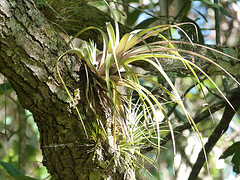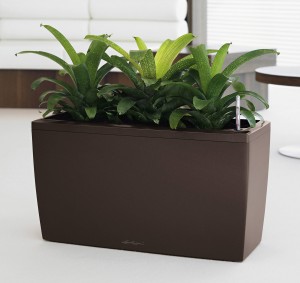Bromeliads: Growing Medium and Mounting Materials
Author: Celeste Booth7 Comments
Care and Culture, Growing Indoors

Growing bromeliads indoors is a great way to add an exotic, tropical feel to your interior designs. In order to care for them, you must have a good understanding of how they grow, what medium they prefer, and what kind of care they require. Before we discuss potting medium, it is helpful to understand how bromeliads collect water and nutrients to grow.
Types of Bromeliads
Bromeliads can be epiphytic, saxicolous, or terrestrial. You are probably most familiar with the latter.Terrestrial plants live in the ground. Their roots are anchored in the soil to provide stability and absorb nutrients and water. Epiphytic bromeliads grow attached to other plants, usually trees. They non parasitic using their roots to anchor themselves to the host plant. Epiphytes gather water and nutrients from the air with small hairs called trichomes. Saxicolous bromeliads grow on rocks and gather water and nutrients in the same manner as epiphytes. Many bromeliads have the ability to live as either epiphytes or terrestrials.
Terrestrial Bromeliads
Terrestrial bromeliads require special potting medium. They cannot grow in regular soil as it is too heavy for for these air loving plants. Mixes can vary greatly and it may take some trial and error to find the mix that is perfect for the type of bromeliad you are growing. In general, bromeliads prefer an acidic mix. The medium must also be coarse so that water quickly drains away from the roots. Bromeliads like to be damp but not soggy. If the roots stay too wet for a prolonged period of time, they will experience rot. The potting mix must be light and airy as well. Bromeliads roots do not respond well if they are tightly packed. The safest option is to purchase potting mixes that are formulated specially for bromeliads. Some orchid medium can work as well. If you choose to make your own potting mixture, use ingredients such as humus, orchid bark, coarse perlite, pumice, sphagnum moss, and tree fern fibers. This will create a coarse potting mixture will provide plenty of movement and drainage for your bromeliad.
Choosing a Container
When choosing a container, consider your location and watering habits. If you have a tendency to over-water or you are keeping your bromeliad in a humid environment, you may want to use a clay pot. This will allow the soil to dry out faster and prevent the roots from becoming too soggy. If you are in a dry climate or are keeping your plants indoors where there is a lot of air flow, such as heat or air conditioning, you may want to use a plastic or ceramic container. These containers will keep the roots moist and prevent them from drying out.
The size of a bromeliad is not an indication of how large your pot should be. Roots for bromeliads are relatively small and prefer a smaller pot. Using too large of a pot will often times lead to root rot because the medium will not drain as quickly and cause the bromeliad’s root system to sit in water. Most bromeliad species will do well in containers that are 4 to 6 inches in diameter. If the bromeliad becomes top heavy in such a small container, you can use a larger pot as an anchor by filling the larger pot and then placing the small pot that contains the bromeliad inside.
Mounting Epiphytes
Epiphytic bromeliads can be mounted on various structures. There are a few different methods for mounting epiphytes, but most involve untreated wood. Cork bark and tree fern slabs are commonly used for mounting. Cedar, juniper, oak, mesquite, and rosewood are good woods to use that are rot resistant. Stumps can also make unique mounts. Make sure that regardless the type of wood you choose it is untreated and salt free. Wood that has been treated with copper will kill the bromeliad. Any rough and porous surface free of chemical will work as a mount.

-Epiphytic bromeliad
Once you have found a mount, you can choose your plant. Many plants in the genera Tillandsia, Billbergia and Aechmeas are epiphytes that will mount nicely. It may find it easier to mount pups as their root systems have not yet matured. If you use plants that have already formed roots, you will need to cover these soft roots with sphagnum moss. The moss must be moistened regularly in order for the soft roots to take up nutrients. There are many different materials you can use to attach your bromeliad to its mount .Fishing line, PVC covered wire, string, certain types of glue, and even strips of nylon stockings are suitable. When using wire, make sure that no copper comes in contact with your bromeliad. If you plan to glue your bromeliad to its mount, use the smallest amount of non-toxic glue as possible to achieve the bond.
With any mounting material, you will want to secure the plant to the mount so that it does not wiggle. Allowing for movement on the mount can cause the bromeliad’s sensitive roots to break off.
Humidity
Keep in mind that mounted bromeliads need much more water and higher humidity than terrestrial bromeliads. If the air is exceedingly dry, roots may have difficulty attaching and foliage will suffer. One way to keep air moist in dry indoor climates is to place a tray of pebbles or decorative rocks filled with water below or near the mounts. The water will evaporate into the air and make the environment around the bromeliads slightly more humid. It is still important to keep a careful eye on mounted bromeliads and water them regularly. Misting mounted plants with a spray bottle is recommended.
Points to Remember
There are several things to keep in mind as you establish your bromeliads,
- If you are mounting epiphytes, use rot resistant wood that has not been treated.
- Take care to make sure the plants are fastened securely.
- Make sure your mounted plant is receiving enough moisture.
- If you are potting a bromeliad, use coarse potting mix that is acidic.
- Plant your bromeliad in a 4-6 inch pot. If your plant is too large, place the small pot within a larger container for stability.
Growing bromeliads can be fun and easy. Your plants will get the healthiest start if they are established in the proper growing medium and environment.
Sources
“Bromeliad Basic Culture” Collecting Bromeliads and Orchids in Florida. http://www.jacksbromeliads.com/basicculture.htm
“Bromeliaceae” Wikipedia http://en.wikipedia.org/wiki/Bromeliad
“Mounting Bromeliads” Bromeliad Society Internationl, Odean Head,
http://www.bsi.org/brom_info/growing/mounting.html
Featured image photo credit: Katie Spence via https://www.flickr.com/photos/spenceke/3275533130/
Epiphytic bromeliad photo credit: Lisa Jacobs via https://www.flickr.com/photos/bunnygoth/7113826939/
7 Responses to “Bromeliads: Growing Medium and Mounting Materials”
Leave a Reply

Resource Download
Hechtia Care Cheat Sheet
Learn how to care for your Hechtia bromeliad with this quick and easy informational guide.
Learn More
Ask an Expert
Questions about bromeliads?
Our experts love a challenge!
Photo of the Week
Submit your photo to be featured on the blog!
More Photo of the Week Winners
Submit Photo









Hello, I’ve just bought my first bromeliad and found this site to see hoe to care for it. I was wondering where you got the image above of Ephiphyte Bromeliad as I’m an artist and really love that picture and would like to draw it. Can you tell me where you found that specific image?
many thanks
A friend at work gave me her “old” bromeliad which actually consisted of 5 plants! I’ve repotted them into two containers (and after reading the above realize the containers are too big) but have no idea how to care for them. I was going to give one container to my mom, but want to make sure I have them stable before giving to her. I also need to know about pruning please! I can post a picture, too, since I have no idea what family they are!
Think I have a tankless terrestrial like that one pictured above. I have blooms! Nice purple on a pink bromeliad. Never seen them bloom before. What are the best blooming conditions as this had begun to bloom when I bought it? I would like to continue blooming it.
My plant has many shoots and is top heavy…it is turning brown and dying…I want to save it. What can I do. I think it started when i put one of those self watering gloges in it. some of the shoots have come apart i just stuck them in water to see if they will re root…will they? Im going to get some fresh soil to its specs course acitic.
When i first got it i was putting water in the tubes and had a flower emerging but then it pulled back..why….I want to bring this plant back and get it to bloom. Any tips are appreciated here…thank you. Jason
your probably giving it too much water…i would take the watering globe out. good luck!
I have just been given a Bromilia brigada as a present. I’m not very plant friendly. Instructions say to make sure there is water in the tube. Can someone please tell me if the tube is the center of the plant? And also is there any other tips that will help a long life? cheers Julia
the common bromliad you see in nurseries – can they grow in air, meaning if you put them in a hanging basket with out soil will they grow?